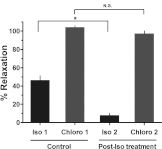TAS2R activation promotes airway smooth muscle relaxation despite β(2)-adrenergic receptor tachyphylaxis
- PMID: 22683571
- PMCID: PMC3423830
- DOI: 10.1152/ajplung.00126.2012
TAS2R activation promotes airway smooth muscle relaxation despite β(2)-adrenergic receptor tachyphylaxis
Abstract
Recently, bitter taste receptors (TAS2Rs) were found in the lung and act to relax airway smooth muscle (ASM) via intracellular Ca(2+) concentration signaling generated from restricted phospholipase C activation. As potential therapy, TAS2R agonists could be add-on treatment when patients fail to achieve adequate bronchodilation with chronic β-agonists. The β(2)-adrenergic receptor (β(2)AR) of ASM undergoes extensive functional desensitization. It remains unknown whether this desensitization affects TAS2R function, by cross talk at the receptors or distal common components in the relaxation machinery. We studied intracellular signaling and cell mechanics using isolated human ASM, mouse tracheal responses, and human bronchial responses to characterize TAS2R relaxation in the context of β(2)AR desensitization. In isolated human ASM, magnetic twisting cytometry revealed >90% loss of isoproterenol-promoted decrease in cell stiffness after 18-h exposure to albuterol. Under these same conditions of β(2)AR desensitization, the TAS2R agonist chloroquine relaxation response was unaffected. TAS2R-mediated stimulation of intracellular Ca(2+) concentration in human ASM was unaltered by albuterol pretreatment, in contrast to cAMP signaling, which was desensitized by >90%. In mouse trachea, β(2)AR desensitization by β-agonist amounted to 92 ± 6.0% (P < 0.001), while, under these same conditions, TAS2R desensitization was not significant (11 ± 3.5%). In human lung slices, chronic β-agonist exposure culminated in 64 ± 5.7% (P < 0.001) desensitization of β(2)AR-mediated dilation of carbachol-constricted airways that was reversed by chloroquine. We conclude that there is no evidence for physiologically relevant cross-desensitization of TAS2R-mediated ASM relaxation from chronic β-agonist treatment. These findings portend a favorable therapeutic profile for TAS2R agonists for the treatment of bronchospasm in asthma or chronic obstructive lung disease.
Figures







Comment in
-
Future bronchodilator therapy: a bitter pill to swallow?Am J Physiol Lung Cell Mol Physiol. 2012 Dec 1;303(11):L953-5. doi: 10.1152/ajplung.00303.2012. Epub 2012 Sep 28. Am J Physiol Lung Cell Mol Physiol. 2012. PMID: 23023969
References
-
- Adler E, Hoon MA, Mueller KL, Chandrashekar J, Ryba NJ, Zuker CS. A novel family of mammalian taste receptors. Cell 100: 693– 702, 2000 - PubMed
-
- An SS, Askovich PS, Zarembinski TI, Ahn K, Peltier JM, von Rechenberg M, Sahasrabudhe S, Fredberg JJ. A novel small molecule target in human airway smooth muscle for potential treatment of obstructive lung diseases: a staged high-throughput biophysical screening. Respir Res 12: 8, 2011 - PMC - PubMed
-
- An SS, Laudadio RE, Lai J, Rogers RA, Fredberg JJ. Stiffness changes in cultured airway smooth muscle cells. Am J Physiol Cell Physiol 283: C792– C801, 2002 - PubMed
Publication types
MeSH terms
Substances
Grants and funding
LinkOut - more resources
Full Text Sources
Other Literature Sources
Research Materials
Miscellaneous

